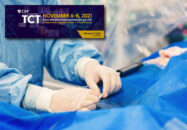According to this new meta-analysis (presented at AHA 2021 and published in The Lancet), mortality is similar between surgery and angioplasty to treat left main coronary artery in patients with simple or intermediate anatomy. This new study estimates that, after 5 years, mortality with surgery would be 11.2% vs. 10.2% with angioplasty, a non-significant difference. This debate…
TCT 2021 | OPTIMUM: Surgically Ineligible Patients with Complex Anatomy: Do We Accept the Case?
In surgically ineligible patients with complex coronary anatomy short term risk of death with PCI is considerably lower than the estimated surgical risk. These are the outcomes of the OPTIMUM registry, presented during the TCT scientific sessions. The good short-term outcomes highlight the importance of trying percutaneous revascularization to treat complex patients. The current data…
TCT 2021 | FAVOR III: Angiography-Derived FFR: An Event-Prevention Tool
Compared with visual estimation of lesions, using quantitative angiography-derived fractional flow reserve (quantitative flow ration, QFR) provides better clinical outcomes at one year for angioplasty. These results emerge from the Chinese FAVOR III study, presented at the 2021 TCT scientific sessions and simultaneously published in The Lancet. The simplicity and safety offered by QRF—since there is…
TCT 2021 | FAME 3: Surprises in a Long-Awaited Study
Angioplasty could not reach non-inferiority to surgery to treat patients with three-vessel lesions. In this head-to-head study of both revascularization strategies in patients with three-vessel coronary disease, fractional flow reserve (FFR)-guided angioplasty could not reach the performance of myocardial revascularization surgery in relation to a composite of adverse events. The FAME 3 study was presented during…
ISCHEMIA: Prognosis is Determined by Anatomy, not Functionality
The ISCHEMIA study keeps providing scientific news. This work in patients with stable coronary artery disease had already shown (to our surprise) that ischemic burden does not predict 4-year mortality. Now, this new analysis suggests that anatomic severity can predict events. However (surprisingly, once more), altering this severity through angioplasty does not change the prognosis…
More Screening Needed Before Non-Cardiac Surgery
According to this recent document by the American Heart Association (AHA), troponin should be monitored for at least 3 days after surgery. With about 20% of patients (most of them, asymptomatic) showing elevated troponin after a non-cardiac surgery, this new AHA document recommends monitoring, for at least two days, patients with moderate to severe ischemia. Myocardial…
Prevalence of Subclinical Coronary Atherosclerosis in the General Population
Early detection of coronary artery disease (CAD) using computed tomography (CT) and calcium score (CAC) might help plan prevention strategies years in advance. This study used CT to determine the prevalence and characteristics of atherosclerosis in the general population. Non-contrast images were scored for CAC. After that, all images with atherosclerosis potential were assessed segment…
XIENCE SHORT DAPT | Ideal DAPT Period for Patients at High Risk of Bleeding
In patients at high risk of bleeding undergoing coronary stenting with a Xience stent, 1-to-3-month DAPT period resulted non-inferior to a 6-to-12-month period in terms of ischemic events, and this could be associated to a lower rate of major bleeding and lower stent thrombosis incidence. There is no longer an indication for conventional stents in…
ESC 2021 | RIPCORD-2: Routine FFR Evaluation of All Epicardial Vessels During Angiography
The predecessor of this research—RIPCORD, published in 2014—showed that using fractional flow reserve (FFR) changes the treatment strategy in about 25% of patients. That marked the rise of FFR. In fact, the DEFER, FAME, and FAME 2 studies offered results consistent with the original RIPCORD. In this research, authors tested the hypothesis of systematic use of…
ESC 2021 | MASTER DAPT: Dual Antiplatelet Therapy After Coronary Angioplasty in Patients at High Bleeding Risk
Courtesy of Dr. José Álvarez. In patients at high bleeding risk with drug-eluting stents, the duration of dual antiplatelet therapy has been subjected to ongoing review. Guidelines from the European Society of Cardiology (ESC) and the American College of Cardiology (ACC) suggest shortening this treatment to a maximum of three to six months (Class IIb).…
Post PCI Same Day Discharge: from Convenience to Need
Same day discharge following programed PCI with no complications has been a way for health centers to reduce costs that has resulted both safe and convenient for patients. With the arrival of the pandemic, reduced bed capacity, uninfected patient exposure and their potential contagion, and the always pressing need to reduce hospital costs have turned…










